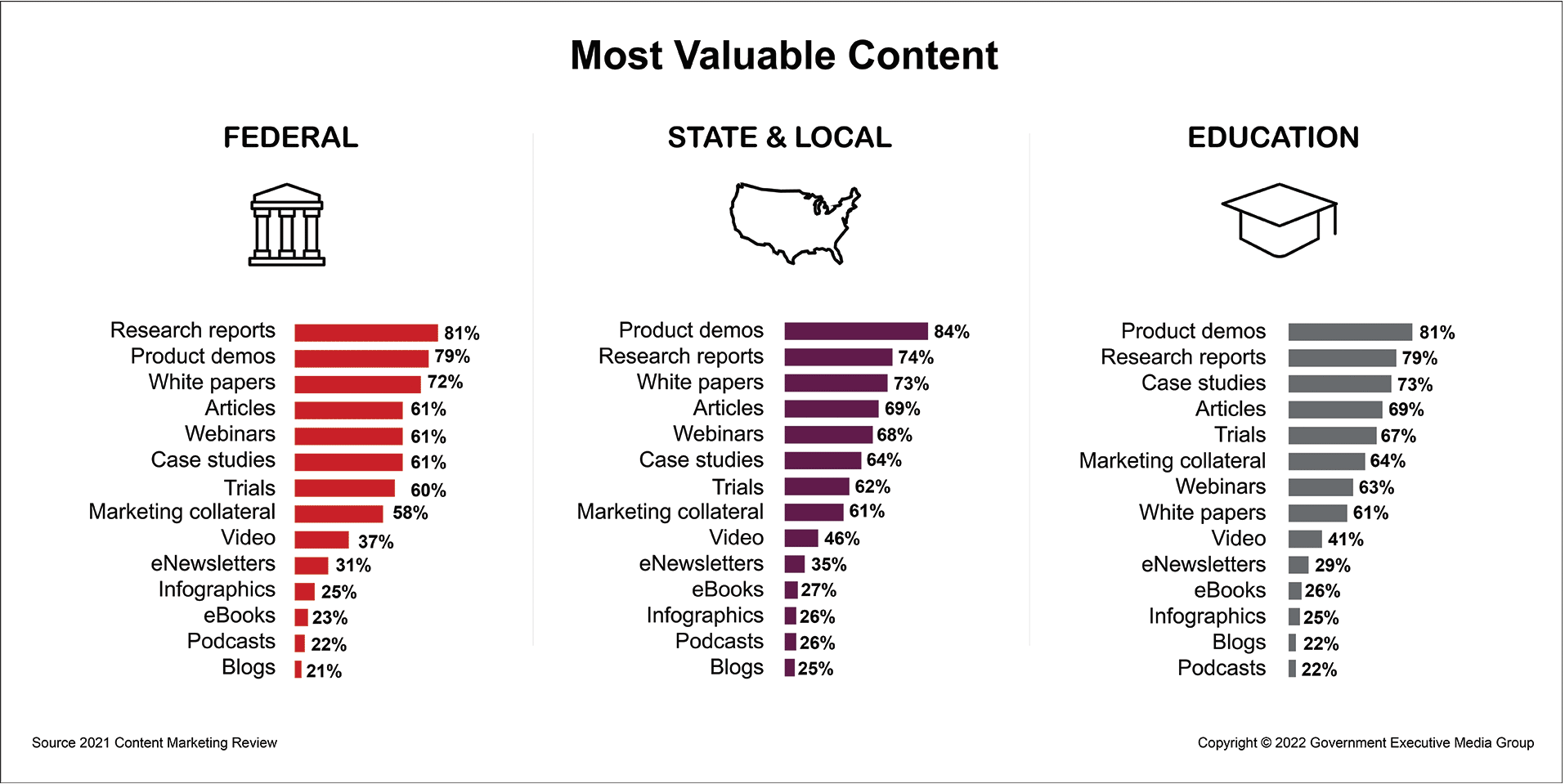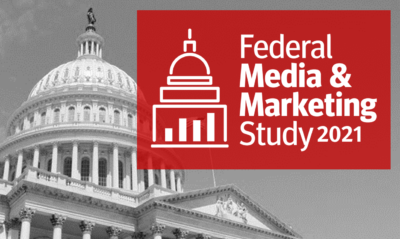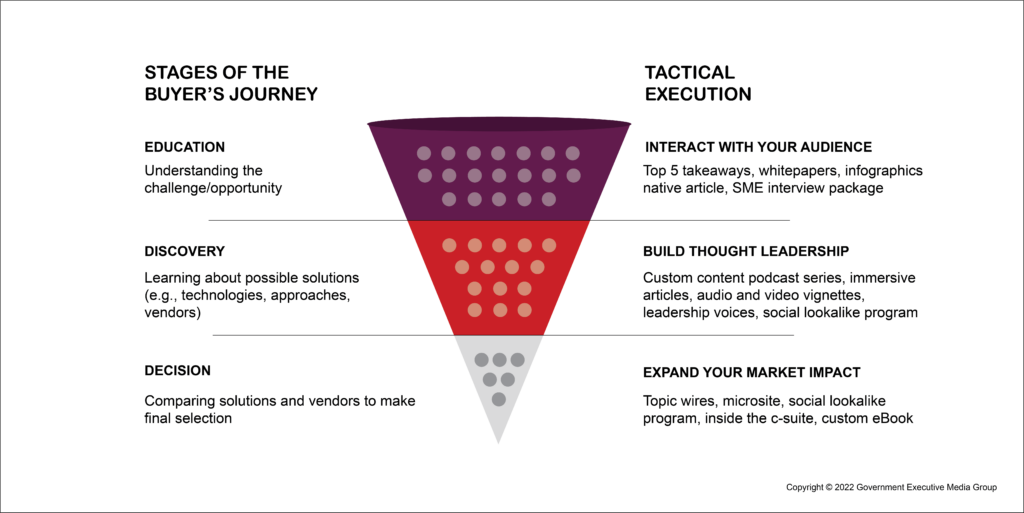federal market research
What is custom content and why does it need to be part of your 2023 marketing plan?
by Susan Rose, Senior Director of Insights and Content
As part of a company that produces every type of content, we find “content” means different things to different people, and some new definition pops up every single day. This can make determining the right content mix to meet your business goals a bit of a challenge.
At GovExec, we talk about editorial content, sales content, and custom content. All types of content are an important part of a marketing strategy. Deciding which one to use in any given situation depends on what your expectations and needs are.
Fortunately, we have some research to help you figure that one out as you start working on your 2023 marketing plan. But first, what is custom content?
What custom content is NOT
It is important to know what it is NOT before diving into what it is. Custom content is neither editorial nor sales content.
Editorial content is designed to inform or entertain. It is what we call “newsworthy” because it tends to be about something happening in the moment, like coverage of a vote in Congress or the war in Ukraine. Editorial content is about what is happening on the ground.
Sales content, on the other hand, is created for the explicit purpose of generating sales. That means it will talk about how a specific product or a specific service is going to work for a public sector agency: what it’s going to do and why the client needs to purchase it. It will not be a broader discussion about the technology; it’s going to be about something very tangible.
Since that seems like the majority of content you see daily, what is custom content then?
What Custom Content is
Custom content is the practice of marketing via content a business funds or sponsors. Editorial content does not have any sponsor and sales content is all sponsor.
When a company underwrites a custom content piece, we work with them to determine the topic and what the audience needs to know or learn. Custom content is relevant and valuable to the audience, and as such helps build trust.
In general, custom content will be based on research. We will dig into studies and reports, or look at industry wide trends. The result will be an unbiased story about what the data means. This content relies on the knowledge of subject matter experts as well as reputable research sources.
Custom content includes native articles, research reports, webinars, podcasts, and videos. When you see something on our GovExec properties that says “sponsored by,” that means it is custom content and a company paid to create it. They helped determine the topic and the educational focus. They have NOT determined what we say because if the research doesn’t back up a specific point of view, we are not going to publish it. Our reputation is on the line. Custom content simply means the company had some influence in topic and direction, and therefore the piece is not pure editorial.
Why do you need to add Custom Content to your 2023 marketing plan?
Custom content is about building that trusted adviser relationship that your team wants to have with your public sector customers. Everything we do is geared toward that.
Why is this so important?
Glad you asked.
Market Connections conducts a variety of studies that look at public sector marketing and trends. Data from our three most recent studies come to the same conclusion: custom content resonates with your audience.
That is ultimately why you need to use it.
In the Market Connections Content Marketing Review, we asked public sector decision makers what kind of content they find most valuable overall. What this data shows is that the public sector values a range of content types.

When we remove editorial and sales content from the mix, you’ll see that custom content types are valuable to the audience—particularly fed and sled audiences.
A little background: We chose 14 different content types because these are all part of the public sector marketing mix.
The figure shows that overall, the public sector audience finds all of them valuable, and therefore are all a really good part of your content mix. Remember that.
But what this also shows is that when you remove editorial and sales content from the mix (which is what we’ve covered up) is that of the 14 content types, 10 are custom content.
Research Reports are highly regarded as valuable content, followed by white papers, and articles. Does that mean you need to spend all of your budget on research? Not necessarily. It depends on your budget and your annual goals. And while your audience really likes reports and white papers, you’ll notice that webinars still have a very high percentage of value to the audience.
What does a custom content mix look like in action?
That’s a great question that only you can answer based on your marketing budget, initiatives, and company goals. This figure of the buyer’s journey illustrates where various types of content have impact along the journey. It’s important to address the audience at the various stages of the journey.
We suggest a mix of ebooks, webinars, articles, video, podcast, white papers, and so on–really anything from the list in the figure.
What we definitely suggest is getting the most out of the content you create. Repurpose, repurpose, repurpose.
Say you commission some custom research, you can get a research report, a white paper, a few articles, a webinar, a podcast, and more out of it. That will give you the most bang for your marketing dollar.
Need some help? Contact your GovExec sales rep to discuss a program to fit your needs. Or, contact me–I love talking content strategy! (srose@govexec.com)

Federal Media & Marketing Study 2021
13th Annual Study: On-Demand Video and Presentation Followed by Small Group Discussions
UPDATE! The 2021 FMMS will now be On-demand
Release date: October 21, 2021
Due to concerns with COVID-19 variants, forthcoming mandates, and to protect the health and safety of our participants, we have made the executive decision to transition the 2021 Federal Media & Marketing Study release to on-demand video presentation and download report.
In its 13th year, the Federal Media & Marketing Study continues to empower marketers to hone and perfect their strategic marketing campaigns with valuable and reliable data directly from their federal customers. The survey provides key information about the federal audience’s media usage across print, broadcast, social and digital sources. Combining this data with demographics including: job function, location, purchase area and more, marketers have the ability to slice and dice the data and map each to specific media habits, allowing them to target specific audiences.
The survey represents the views of thousands of federal workers in a variety of positions. Whether you are interested in a broad awareness campaign, or a more focused agency-based marketing effort, data from the study can provide you key insights about the media and marketing habits of this tough-to-reach federal market audience.
WHAT TO EXPECT
- Job Function and Purchase Responsibility – More than 25 different job functions and areas of purchase, by product and service
- Media Usage – 60+ publications, 100+ websites and mobile sites; 10+ social sites; differences inside vs. outside the Beltway
- Trusted Content -To what extent do decision makers trust news and information from different media sources?
- Time Spent Accessing Content – How much time do government employees spend accessing content online, watching TV, listening to the radio and reading e-newsletters?
TWO PANEL DISCUSSIONS
Federal Media Panel: Moderated by Aaron Heffron, Market Connections
- Kevin Baron, Executive Editor, Defense One
- Patti Nuttybombe Cochran, Federal Marketing Consultant, Government Matters Media
- Jeffrey Wolinsky, Director of Federal Sales, WTOP/Federal News Network
Federal Marketing Panel: Moderated by Stephanie Geiger, Government Marketing University
- Matt Bechtel, Director of Corporate Marketing, Booz Allen Hamilton
- Allison Mason, Senior Director, Public Sector Marketing, Red Hat
- Darryl E. Peek II, Head of Federal Strategic Partnerships, Google
ON-DEMAND ACCESS and POST-FMMS ONLINE NETWORKING SESSIONS
- ON-DEMAND VIDEO AND REPORT – Our 2021 report and video presentation will be available to download on October 21. Stay tuned for purchasing capabilities
- SMALL GROUP ONLINE DISCUSSIONS – A series of online groups (no more than 20 per session) will be limited to FMMS on-demand purchasers to discuss results and network with like-minded peers following the FMMS release. Details on registration will be available in after purchase.
PURCHASE THE OVERVIEW & VIDEO!
Overview results from the 2021 Federal Media & Marketing Study highlights high-level results from our comprehensive study surveying thousands of federal respondents at defense and civilian agencies, inside and outside the Beltway about their use of digital, social, mobile, print and broadcast media. This PDF report provides high-level results of the top digital and print publications, social media sites, radio and TV within the DC metro area. A video readout and analysis of the results by President, Aaron Heffron, is included with purchase.

Aaron Heffron, President, Market Connections
From the Desk of Aaron Heffron, President, Market Connections, Inc.
In a recent The Curious Task podcast, Dr. Sandra Peart, Dean and E. Claiborne Robins Distinguished Professor at the Jepson School of Leadership Studies at the University of Richmond (Go Spiders!) discussed the life and philosophy of John Stuart Mill. As an economics nerd myself, I found the discussion fascinating as she and host, Alex Aragona, detailed the key principles on which Mill wrote. A review of issues around liberty and utilitarian decision-making abounded. But what I was particularly taken with was Mill’s concept of how you can determine whether one choice is better than another. Enter the “competent judges.”
As marketers, our job is to help make the decision easier for our customers. We spend countless hours and dollars making the case as to why our company’s products or services are a better choice. When faced with two options, we want them to choose us every time.
Market Connections partners with our clients to help identify those in their target market who are more likely to lean one way or another, understand the elements of the product or service that are important to them, and the perceptions and experience they have with various companies. We conduct surveys, run focus groups, and conduct in-depth interviews all in an attempt to mine those hidden diamonds of the decision-making process that will make their product or service more appealing.
While hearing from just your customers or prospects is great, the opinions we value most are what Mill termed the “competent judges,” those who have direct experience with both options available to them. By bringing together those individuals with direct experience, you as a marketer can hear straight from the horse’s mouth as to what worked and what didn’t. You are not relying on perceptions, assumptions, or hearsay; but rather, you are measuring the room, so to speak, and getting a clear view of where your brand stands.
While not always easy to find, these judges are a key gateway to a path forward for you and your sales team. To support these efforts, Market Connections has spent the last decade building a panel of thousands of public sector influencers and decision-makers that we reach out to on a regular basis. Working across civilian and defense agencies, these individuals have had exposure to scores of contractors, vendors, and products. We have been leveraging these “competent judges” for insights for years, creating studies and reports that support your efforts and strategies.
Contact me if you want to discuss leveraging our “competent judges” for your specific market needs.


